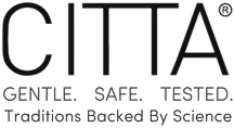Blogs
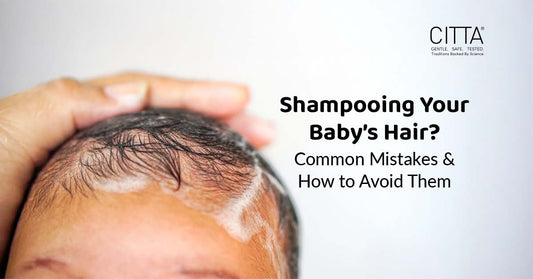
Shampooing Your Baby’s Hair? Common Mistakes an...
Some babies love getting their hair washed, enjoying their little splish-splash bathing adventures, bubbles, and squeaky-clean moments. However, others detest hair wash sessions, turning them into a challenging ordeal filled...
Shampooing Your Baby’s Hair? Common Mistakes and How to Avoid Them
Some babies love getting their hair washed, enjoying their little splish-splash bathing adventures, bubbles, and squeaky-clean moments. However, others detest hair wash sessions, turning them into a challenging ordeal filled with screams and cries. If this sounds familiar, you might be making some common mistakes while shampooing your baby’s hair. Read on to learn how to make hair-washing a more pleasant experience for your little one! Common Mistakes While Shampooing Baby’s Hair Overwashing Your Baby’s Hair You must be thinking frequent hair wash will keep your baby’s hair and scalp clean. But the truth is washing your baby’s hair too frequently can strip away natural oils, leading to dryness and irritation. Babies generally only need their hair washed two to three times a week. This helps maintain the scalp’s natural moisture balance, keeping hair healthy and soft. Ignoring Water Temperature The water temperature should be neither too hot nor too cold. Ideally, the water should be lukewarm as too hot water can cause discomfort and dryness. Besides, too cold water can make the hair washing experience unpleasant for your little one. Before starting the wash, make sure to check the temperature with your wrist or elbow. Using Shampoo with High pH Levels Your baby’s scalp is 20x more delicate than yours. Shampoos with high pH levels can be harsh on your little one’s scalp, causing dryness and irritation. Always go for a shampoo specifically crafted for babies with gentle formulations and a pH level close to that of their skin. A gentle, tear-free shampoo like CITTA’s Gentle Foaming Baby Shampoo is ideal for newborns and kids. Enriched with the goodness of coconut oil, almond oil, olive oil, and oats, this natural baby shampoo gently cleanses your baby’s hair while preventing scalp conditions like cradle cap, also referred to as infantile seborrheic dermatitis. Scrubbing with Nails Scrubbing your little one’s scalp using nails can cause irritation and discomfort. Always massage the scalp gently with your fingertips. This will help remove any buildup without damaging the skin or causing distress. Not Detangling Hair Before Washing If your baby has longer hair, detangling it before washing can make the process smoother and less painful. Use a wide-toothed comb or a soft brush to gently remove tiny knots or tangles before wetting the hair. The Right Way to Wash Your Baby’s Hair Wet the hair with lukewarm water. Apply a small amount of baby shampoo to your palm. Massage gently with fingertips, never nails. Rinse thoroughly to remove all residue. Pat dry with a soft towel, don’t rub harshly Why Choosing the Right Shampoo Matters When it comes to your baby, the choice of shampoo makes all the difference. The right shampoo should: Be tear-free & pH-balanced Contain natural, nourishing ingredients Prevent scalp dryness & cradle cap Be dermatologist-tested & chemical-free CITTA’s Gentle Foaming Baby Shampoo is crafted with dadi-nani ke nuskhe and modern science, ensuring every wash is safe, soothing, and nourishing for your little one. Add to cart Also Read: How to Choose a Moisturizer for Babies with Dry Skin and Patches FAQs 1. How often should I wash my baby’s hair? It is generally recommended to wash your baby’s hair two to three times a week. This helps maintain the scalp’s natural moisture balance. 2. What should the water temperature be when washing my baby’s hair? The water should be lukewarm. Always check the temperature with your wrist or elbow to ensure it is not too hot or too cold for your baby. 3. What type of shampoo should I use for my baby? Choose a gentle, tear-free shampoo specifically formulated for babies. Look for products with a low pH level and natural ingredients like coconut oil, almond oil, olive oil, and oats. This will help keep your baby’s scalp healthy and prevent conditions like cradle cap. 4. What is a cradle cap and how to prevent it? Cradle cap, or infantile seborrheic dermatitis, is a common scalp condition in babies, marked by flaky, crusty, or oily patches on the scalp. Using a gentle baby shampoo, like CITTA’s Gentle Foaming Baby Shampoo, and rinsing thoroughly, can help prevent it. Regularly brushing your baby’s scalp with a soft brush and keeping it moisturised can also help maintain a healthy scalp. Also Read: How to Remove Sunscreen from Baby's Face Safely & Gently
Read More
Oil Massage For Babies: Not Just A Winter Ritual
When it comes to baby care, parents naturally strive to provide the best for their little ones. Even something as seemingly simple as choosing the right massage oil becomes a...
Oil Massage For Babies: Not Just A Winter Ritual
When it comes to baby care, parents naturally strive to provide the best for their little ones. Even something as seemingly simple as choosing the right massage oil becomes a significant decision. Contrary to popular belief, oil massage is not just a winter ritual; it is a year-round necessity. Yes, you read that right! Many parents mistakenly limit oil massage to the winter months. While winter may amplify the need for extra tender loving care, using a natural, non-sticky, and chemical-free massage oil for your newborn is beneficial throughout the entire year. Whether it’s winter or any other season, selecting the right massage oil for your little one infused with the goodness of all-natural ingredients is crucial. Benefits Of Regular Oil Massage For Babies According to the American Academy of Pediatrics, regular oil massage can benefit babies’ health in multiple ways. Read on to know some of the most compelling reasons to incorporate oil massage into your baby’s routine all year round: Oil Massage Promotes Quality Sleep Regular oil massage has been shown to promote better sleep patterns in infants. A study published in the Journal of Clinical Nursing found that infants who received regular massages slept better and longer than those who did not. Quality sleep is essential for a baby’s growth and development. Oil Massage Enhances Flexibility Gentle massaging can improve the flexibility and strength of a baby’s arms and legs. It stimulates muscle development and helps in building coordination and motor skills, which are crucial for a baby’s physical milestones. Oil Massage Lowers The Stress Levels Massage has a soothing effect on babies. It helps reduce levels of stress hormones like cortisol. The calming touch during a massage releases endorphins, which can help keep babies happier and more relaxed. Oil Massage Relaxes Muscles Regular massages help to relax the baby’s muscles, alleviating any tension or discomfort they might experience. This is particularly important as babies grow and start to move more. Oil Massage Promotes Digestion Massaging a baby’s abdomen can aid in digestion and alleviate common issues such as gas and colic. This can be particularly beneficial after feeding, ensuring that the baby is comfortable and happy. Oil Massage Reduces Skin Sensitivity Using nourishing massage oils with natural ingredients can help maintain the baby’s skin health, keeping it moisturized from within and reducing the risk of skin irritations and sensitivities. Regular massages can also help in detecting any skin problems early. Oil Massage Boosts Immunity Regular massage can enhance the baby’s immune system by improving blood circulation and stimulating the lymphatic system. This helps in the efficient removal of toxins and supports the body’s natural defense mechanisms. Choosing The Right Massage Oil With a plethora of options available in the market, choosing the right massage oil for your little one can be a little discombobulating. Remember, when selecting a massage oil for your baby, it is essential to go for natural, non-sticky, and chemical-free options. Opt for a natural nourishing baby massage oil that is enriched with the goodness of natural oils like sunflower oil, castor oil, sesame oil, coconut oil, olive oil, almond oil, ashwagandha oil, turmeric oil, camphor oil, brahmi oil, basil oil, and cinnamon oil. All these potent ingredients along with vitamin E provide multiple benefits, working together to keep your baby’s delicate skin nourished and moisturized. The Bottom Line Incorporating oil massage into your baby’s routine should be a year-round practice. The benefits extend far beyond the winter months, contributing to better sleep, reduced stress, improved flexibility, relaxed muscles, enhanced digestion, boosted immunity, and healthier skin. Dermatologist-tested and grandma-approved, CITTA’s Natural Nourishing Baby Massage Oil is the perfect choice to pamper your little one throughout the year.
Read More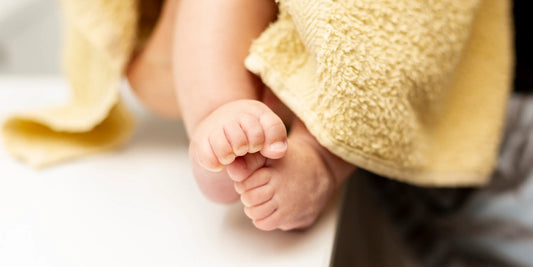
Say Goodbye To Post-Bath Dryness By Choosing Th...
Babies’ outermost skin layer is 20 times thinner and more delicate than adults, making it more sensitive and prone to moisture loss and dryness. Therefore, it’s essential for parents to...
Say Goodbye To Post-Bath Dryness By Choosing The Right Baby Wash For Your Little One
Babies’ outermost skin layer is 20 times thinner and more delicate than adults, making it more sensitive and prone to moisture loss and dryness. Therefore, it’s essential for parents to choose products that maintain the skin’s natural pH balance. When selecting a baby wash for your newborn, it’s crucial to find one that doesn’t strip the natural oils from their delicate skin. Many baby soaps contain harmful chemicals and detergents that can lead to post-bath dryness. Opting for a gentle, pH-balanced baby wash ensures your little one’s skin remains soft, hydrated, and irritation-free. What Causes Post-Bath Dryness? Baby skin is incredibly delicate. The fragility of their skin makes them prone to dryness, irritation, and redness. The surface of the skin contains natural oils and moisturizing molecules that protect its moisture barrier. Using soaps with harsh chemicals or over-washing your baby’s skin can strip these natural oils away, leading to post-bath dryness. To prevent this, it’s best to use a baby wash infused with natural ingredients like aloe vera and coconut oil. These gentle formulations maintain the protective barrier of the skin. Natural plant-based ingredients can help seal in moisture while keeping out external irritants. To keep your baby’s skin soft and healthy, it’s crucial to establish a gentle and nourishing bath routine. Here are some tips to follow: When bathing your baby, opt for warm water instead of hot. Hot water can strip away the natural oils from your little one’s skin, leaving it itchy and dry. By choosing a gentle, natural baby wash and using warm water, you can ensure your baby’s skin stays soft, hydrated, and healthy. Bathe your baby only 2-3 times a week to avoid stripping away natural oils. Use gentle washes formulated with skin-barrier-protecting and hydrating ingredients. After bathing your baby with a natural tender foaming baby wash, make sure to gently pat them dry with a towel. Post-bath, moisturize with a nourishing baby balm to help seal in moisture and protect their delicate skin. Choose a Mild, Gentle Baby Wash for Your Precious One Selecting the right baby wash is crucial for your baby’s delicate skin. Prioritize mild and gentle formulations that are free from harsh chemicals, toxins, and dyes. Many conventional baby washes contain artificial ingredients, silicones, mineral oils, sulfates, and parabens, which can cause dryness, allergies, and skin irritation. Opting for natural baby washes minimizes these risks, offering a safer and gentler alternative. When choosing a baby wash, always check the label for a complete list of ingredients. Look for nourishing natural ingredients like aloe vera, coconut oil, and hydrolyzed rice protein. These ingredients provide multiple benefits, working together to keep your baby’s skin nourished and moisturized from within. Aloe vera soothes and hydrates, coconut oil provides deep moisturization, and hydrolyzed rice protein helps to maintain the skin’s natural barrier. After bathing your baby with a gentle, natural foaming baby wash, make sure to pat them dry with a soft towel. Follow up with a moisturizing baby balm massage to lock in moisture and protect their skin from environmental stressors. Final Thoughts Bathing should be a gentle and enjoyable experience for your baby, and selecting the right baby wash can ensure just that. Opting for a gentle baby wash with all-natural ingredients is key to maintaining your baby’s skin health and happiness. CITTA’s Natural Tender Foaming Baby Wash is a perfect choice for your little one’s bath time routine. Formulated with gentle, all-natural ingredients like aloe vera, coconut oil, and hydrolyzed rice protein, this baby wash helps alleviate skin issues, get rid of post-bath dryness and keeps your baby happy and healthy. Make every bath time a happy and delightful experience for your little one!
Read More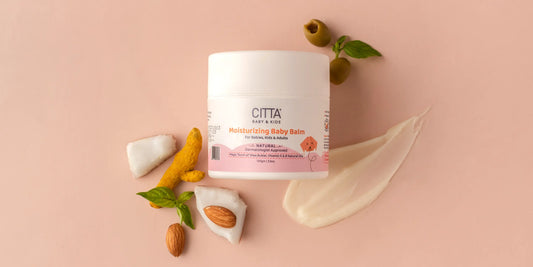
Why CITTA’s Moisturizing Baby Balm Is An Indulg...
We could expect nothing else but pure decadence from CITTA’s Moisturizing Baby Balm. One of our most coveted offerings, the Natural Moisturizing Baby Balm has become a favorite among discerning...
Why CITTA’s Moisturizing Baby Balm Is An Indulgent Must-Have for Discerning Parents?
We could expect nothing else but pure decadence from CITTA’s Moisturizing Baby Balm. One of our most coveted offerings, the Natural Moisturizing Baby Balm has become a favorite among discerning parents who demand nothing but the best for their little ones. Thanks to its unparalleled blend of luxury, efficacy, and safety, this premium product has successfully stood out in a crowded market. Here’s why discerning parents are choosing the balm as their go-to skincare solution for their precious ones. The Pinnacle of High-End Skincare Ingredients Meticulously crafted using only the finest, handpicked ingredients, CITTA’s Moisturizing Baby Balm features shea butter, known for its intense moisturizing properties, and the goodness of eight oils (coconut oil, almond oil, olive oil, rice bran oil, basil oil, camphor oil, soybean oil and turmeric oil). Handpicked for their individual benefits, these natural ingredients create a synergistic effect on the baby’s delicate skin, delivering intense hydration and nourishment. Game-Changing Skincare Unlike water-based lotions or creams that may provide temporary relief, the Natural Moisturizing Baby Balm offers long-lasting hydration that outlasts any conventional baby lotion or cream. Its rich formulation means that a little goes a long way, providing enduring moisture that supports the skin’s natural barrier function. The balm’s luxurious texture ensures that it delivers sustained hydration and keeps your baby’s skin soft, supple, and deeply nourished from within. Transparency and Trust: No Gatekeeping At CITTA, transparency is paramount. Parents can trust that what’s on the label is exactly what’s in the jar. Each ingredient is clearly listed, which means there’s no gatekeeping. This commitment to transparency allows parents to make informed choices about what they apply to their precious one’s skin. Versatile & Ideal For All Seasons The Natural Moisturizing Baby Balm is not only long-lasting but also versatile, making it an ideal choice for all seasons. Its artisanal formulation is designed to provide continuous moisture, protecting against dryness in winter and balancing the skin during more humid conditions. This versatility ensures that your baby’s skin remains perfectly hydrated and protected, no matter the transition of the weather. It absorbs quickly, leaving a silky finish without any residue. Final Thoughts The Moisturizing Baby Balm by CITTA is a luxurious blend of high-end ingredients, transformative quality, and transparent labeling, which makes it a standout choice for parents who refuse to compromise on their baby’s skincare. Aside from that, the fact that it’s formulated with ECOCERT/ COSMOS Organics-certified ingredients makes the Natural Moisturizing Baby Balm – dare we say it? – a must-have in every parent’s arsenal.
Read More
Why Minimalism Matters in Baby Skincare
New parents are naturally inclined to provide the best care for their little ones, even for their skincare routine. However, in their pursuit of perfection, they may overlook a crucial...
Why Minimalism Matters in Baby Skincare
New parents are naturally inclined to provide the best care for their little ones, even for their skincare routine. However, in their pursuit of perfection, they may overlook a crucial aspect, i.e., “minimalism matters” when it comes to babies’ delicate and sensitive skin. With a baby’s skin being more sensitive and delicate than an adult’s, a simple and gentle skincare regimen is essential. Let’s explore why opting for a minimalistic approach is essential for your little one’s well-being. Baby’s Skin Is 20x Thinner Than Adult Skin Baby skin, 20 times thinner than that of adults, demands special care. The fragility of their delicate skin makes it highly vulnerable to external stimuli, leading to irritation, inflammation, and adverse reactions. As their skin barrier is still in its developmental phase, excessive product usage can disrupt this natural process, stripping away essential oils. Understanding the importance of a minimalist and gentle approach is crucial for maintaining your baby’s skin health. Minimalist & Natural Skincare Your little one’s skin deserves the gentle touch of minimalist and natural skincare. Formulations crafted with plant-based ingredients such as oats, shea butter, coconut oil, aloe vera, and ashwagandha offer intense hydration and nourishment without any harmful effects. These natural elements help maintain your baby’s skin-friendly pH balance while nurturing overall skin health. Harsh Chemicals & Potential Irritants Conventional brands often harbor harsh ingredients that can wreak havoc on your little one’s skin, particularly if overused. Prioritize dermatologist-approved brands like CITTA, where every ingredient is listed on product labels, ensuring 100% transparency. Opt for skincare products free from harmful substances such as parabens, silicones, phthalates, polyethylene glycol, and talc, among others, to protect your baby’s delicate skin. Simple Skincare Routine Opt for simplicity in your little one’s skincare regimen rather than overwhelming them with multiple products. Begin by cleansing their scalp and body with a mild, soothing shampoo and body wash for newborns. Remember not to overwash, as it can strip away your baby’s natural oils. Follow up with a natural moisturizing balm to seal in moisture and nourishment. Unlike typical water-based creams or lotions, balms boast a thicker consistency, lasting nearly two months. Additionally, their formulation ensures long-lasting hydration. Your Baby’s Skin Needs Tailored Care Your baby’s skin is unique, with its own set of needs and sensitivities. Observe how their skin responds to various products to make informed decisions. Adjust their skincare routine accordingly, ensuring it aligns with their individual needs. This thoughtful approach prevents overwhelming their skin with unnecessary products and allows for tailored care, promoting optimal skin health. The Bottom Line Less is more when it comes to your little one’s skin. A minimalist approach is vital in crafting any skincare routine for your baby. Their skin is 20 times more delicate and sensitive than yours, necessitating gentle care and maintaining a natural, skin-friendly pH balance. By refraining from overusing products or exposing their skin to harmful substances and adopting a minimalist approach, you can ensure a healthy skincare routine for your little one. At CITTA, we reaffirm the science and efficacy of natural skincare amidst a sea of toxic chemicals prevalent in the bath & skincare industry today. Every ECOCERT/ COSMOS Organics certified ingredient used is listed on the labels, providing peace of mind for parents. Embracing the philosophy that less is more for delicate baby skin, we focus on crafting a decadent skincare experience that is both wholesome and indulgent for babies. If you have any queries or concerns, feel free to comment below. Happy Skincare!
Read More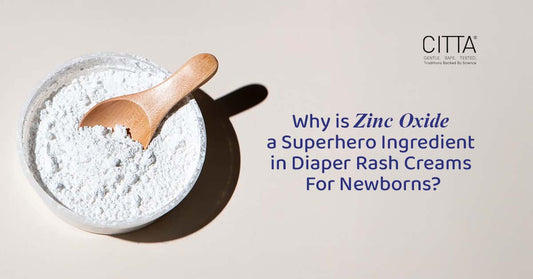
Why is Zinc Oxide a Superhero Ingredient in Dia...
A topical skin product, zinc oxide acts as a protective coating for skin irritations and abrasions. It is a mild astringent that is widely used in diaper rash creams for...
Why is Zinc Oxide a Superhero Ingredient in Diaper Rash Creams For Newborns?
A topical skin product, zinc oxide acts as a protective coating for skin irritations and abrasions. It is a mild astringent that is widely used in diaper rash creams for newborns due to its ability to form a protective barrier on the skin. This barrier helps shield delicate skin from irritants, such as moisture, enzymes, and bacteria present in urine and feces. Concentration of Zinc Oxide in Diaper Rash Creams Diaper rash creams typically contain zinc oxide in concentrations ranging from 10% to 40%. Products with lower concentrations (around 10-20%) are usually intended for routine prevention, while higher concentrations (up to 40%) are used for treating more severe rashes. Add to cart How Zinc Oxide Works According to the American Academy of Dermatology, diaper rash affects up to 35% of infants, which is why effective prevention and treatment is essential. Zinc oxide, a potent ingredient used in diaper rash creams, works through several mechanisms to protect and heal the skin. Creates A Physical Barrier Zinc oxide forms a barrier on the surface of the skin when applied. This barrier acts as a protective coating and blocks irritants like moisture, enzymes, and bacteria from coming into direct contact with the skin. By preventing these irritants, zinc oxide’s protective barrier helps reduce the risk of inflammation, redness, and irritation in the diaper area. Shrinks Irritated Tissues Zinc oxide, as a mild astringent, helps tighten and constrict body tissues, further reducing swelling and redness associated with diaper rash. It helps minimize the inflammation and discomfort that often accompanies rashes by causing the tissues to contract. Prevents Bacterial Growth & Potential Infections Studies published in dermatological journals have documented the antiseptic properties of zinc oxide, which reinforces its role in protecting the skin from microbial threats. It helps inhibit the growth of bacteria on the skin, especially in diaper regions where warm and moist conditions promote bacterial proliferation. Keeps Skin Dry One of the key benefits of zinc oxide in diaper rash creams is its ability to absorb excess moisture, which helps keep the diaper region dry. This is important because prolonged exposure to moisture can break down the skin’s natural barrier, making it more susceptible to irritation and rashes. By maintaining a dry environment, zinc oxide reduces the likelihood of rash development and helps heal existing rashes more quickly. How to Use A Diaper Rash Cream With Zinc Oxide To effectively use a diaper rash cream with zinc oxide, follow these steps: Cleanse the Skin: Thoroughly cleanse the baby’s skin with a soft cloth and warm water. Avoid using harsh soaps or wipes that may further irritate the skin. Dry the Skin: Gently pat the skin dry with a soft towel. Avoid rubbing, as this can cause additional irritation. Apply the Cream: Apply a thin layer of zinc oxide cream to the clean, dry skin. Focus on areas that are most prone to irritation, such as the buttocks, genitals, and skin folds. Change Diapers Frequently: Put on a new diaper, ensuring it is not too tight. Frequent diaper changes help keep the skin dry and reduce the risk of further irritation. Is It Safe For Babies? Absolutely, zinc oxide is considered very safe for use on infants. According to the American Academy of Pediatrics, zinc oxide is recommended for preventing and treating diaper rash due to its minimal risk of adverse reactions and excellent tolerability. It is: Non-toxic and gentle on newborn skin Dermatologist-approved for daily use Highly effective in both prevention and healing This is why pediatricians often recommend zinc oxide-based creams as the first line of defense against diaper rash. Product Spotlight: CITTA Diaper Rash Cream When it comes to choosing the best diaper rash cream for newborn, safety, and effectiveness matter most. CITTA Diaper Rash Cream is carefully crafted with: Zinc Oxide:- Creates a protective barrier & speeds up healing Chamomile Extract:- Soothes irritation and redness Sunflower & Soybean Oils:- Provide 5X moisture to nourish delicate skin Fragrance-free & Toxin-free Formula:- No harsh chemicals, only gentle care This dermatologist-tested cream is lightweight, glides easily, and locks in comfort while keeping rashes away - making diaper time happier for both babies and parents. Conclusion Zinc oxide is truly a superhero ingredient in diaper rash creams, it protects, heals, and comforts delicate newborn skin. By choosing a safe, effective product like CITTA Diaper Rash Cream, you can give your little one gentle protection against rashes, irritation, and discomfort. Because when your baby is happy and rash-free, so are you! FAQ's Can I use diaper rash cream on a newborn under 1 month? Yes, zinc oxide creams are generally safe for newborns. However, always check with your pediatrician before first use. Should I wipe off the diaper rash cream completely at every diaper change? No, you don’t need to scrub it off. Gently clean the area and reapply fresh cream. A thin protective layer can stay on. What if my baby’s rash doesn’t improve with zinc oxide cream? If the rash persists for more than 3–4 days or worsens, consult your pediatrician. It might be due to a yeast infection or another condition.
Read More